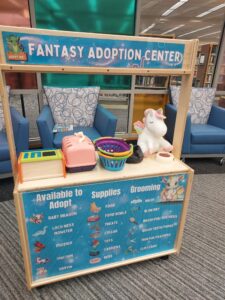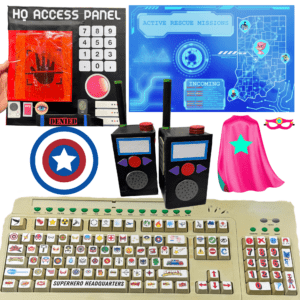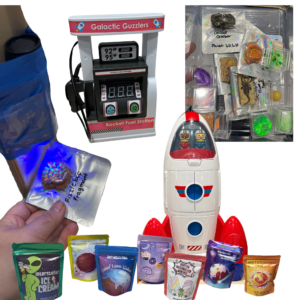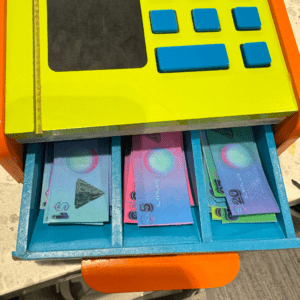14 Jan Dramatic Play
Behind the scenes of dramatic play in the library
Written by Madelyn K., Youth Services Librarian
If you’ve visited our children’s room in the past year, you’ve probably noticed the dramatic playstand near the entrance. From sandwich shops and intergalactic trading posts to fantasy pet adoption centers, potion shops, and superhero headquarters, these playstands have added so much joy and excitement to our space.
I often get questions from parents about how I come up with these ideas, where I find materials, and how they can create similar play experiences at home. So, I thought it would be fun to give you a behind-the-scenes look at the process of building our dramatic playstands and share a few tips for incorporating dramatic play into your child’s everyday life at home.
If you’re feeling inspired to recreate your own dramatic play setup at home or your own library, we’ve got you covered! At the bottom of this blog, you’ll find downloadable files of some of our favorite playstand signs to help you get started.
What is Dramatic Play?
First things first—let’s talk about dramatic play and why it’s so important. At first glance, it might seem like just another way to keep kids entertained, but did you know that every time your child engages in make-believe play, they’re actually building essential skills and developing their minds?
According to Beisly, “Sociodramatic and object play help children develop underlying higher-order thinking skills, like problem-solving and creativity.”
Dramatic play isn’t just fun, it’s a powerful tool for growth!
Coming Up With Ideas
People often ask me, “Where do you get your ideas for the playstands?” The truth is, inspiration comes from a lot of different places– so many ideas I get from my fellow Children’s Room colleagues! But first, I usually start with the basics. Dramatic play often mirrors real life—kids love to play house, doctor, or store. Like our grocery store in the main play area– that’s dramatic play too!
From there, I ask myself: What would have felt truly magical to me as a kid?
Take a classic idea like a pet adoption center. It’s fun, but what if we added a little twist? Let’s make it fantasy-themed, filled with phoenixes, unicorns, and dragons. Suddenly, a familiar concept transforms into a world of endless imagination.
Beyond that, I also draw inspiration from seasonal trends. For example, in October, I set up a Potion Shop to celebrate the magic of Halloween. Seasonal themes not only spark excitement but also make it easier to find fun, affordable props—thank you, dollar store seasonal aisles! Whether it’s spooky potions in the fall or something festive in winter, tying the playstand to the season keeps things fresh, engaging, and visually exciting for our young visitors.
Props
Speaking of props, let’s talk about objects. According to Beisly, “As children play more with objects, they understand how objects may be similar and different, and they are able to link objects together by categories. They also create mental representations of objects that will provide the conceptual foundation of language development.” This is why props are so important!
We gather objects for our playstands from a variety of places, but we always start by using what we already have. Many toys can be completely reinvented when given a fresh context.
The same can be true at home! You might have toys your child hasn’t played with in a while, maybe they just need a little imagination spark. For example, it’s not just a pair of toy binoculars, they’re adventure binoculars, perfect for exploring and observing wildlife at your research base in the Arctic.
Sometimes, all it takes is a simple story or setting to breathe new life into familiar toys.
The next step is creating DIY objects to bring the theme to life. Sometimes, we don’t have a specific item on hand, but that’s where a little creativity (and some crafting) comes in!
For example, when setting up the Superhero Headquarters, I wanted to include walkie-talkies to make the experience more immersive. Since we didn’t have any in our collection, I turned to a YouTube tutorial for inspiration. For our Intergalactic Trading Post, I made “alien artifacts” out of air dry clay and paint. And for our potions shop, I used dollar store bottles and added in my own potions (lots of glitter, water, and oil).
DIY projects like these are a great way to stretch your budget and add unique elements that fit the theme perfectly. Plus, crafting items can be a lot of fun, and it’s a wonderful opportunity to get creative with your kids at home. If you’re making your own dramatic play props, think about what materials you already have and how they can be repurposed into something magical. The possibilities are endless!
One of my favorite details to include in a dramatic playstand is themed fake money. I usually design these in Canva, matching the theme’s color scheme and adding fun little details. At home, you can keep it simple—cut out rectangles from construction paper, add some playful doodles, and let your child’s imagination take care of the rest.
When it comes to the playstand itself, I design all of the signage from scratch. I use Canva to create bold, engaging designs, and we print our two main signs on poster paper. I’ve had a couple people point out that our younger patrons can’t always read all of the signs or silly labels I add to the props. But, according to Ehle, “It provides opportunities to see functional print, like words and numbers on envelopes, mailboxes, menus, and signs, giving them experience with the many ways we use text every day.” It also creates interaction– children have to ask their adult for help to read the signs.
At home, you don’t need fancy tools or large prints to create a similar effect. You can keep your signs smaller and simpler, using materials like poster board, construction paper, or even recycled cardboard. Grab some markers, stickers, or printed images to bring your signs to life, it’s a fun and creative project kids can help with, too!
Our dramatic playstand has six bins that I try to fill with a variety of themed objects to match the current setup. These bins, without fail, get messy very quickly, and they usually stay that way for the duration of the playstand’s run.
But you know what? Messy isn’t always a bad thing! In fact, it’s a sign that children are actively playing, exploring, and learning. Each scattered prop or out-of-place object represents a moment of imagination in action.
Repairs to the props are usually quick and easy, but sometimes the toys and objects simply run their course. When that happens, we let them live out their final adventures before retiring them as we switch to a new playstand. Each change brings fresh excitement—and yes, fresh messes—but that’s all part of the magic!
Our Favorite Moments
Watching our young patrons and their caregivers interact with the dramatic playstand has quickly become one of our favorite joys as a department. There’s something so special about seeing their imaginations come to life in the most unexpected, and hilarious, ways.
We’ve witnessed credit cards getting dramatically declined when attempting to purchase a unicorn, children brewing potions to help their parents sleep better at night, and even our iconic superheroes, Chicken Wing and Captain America, teaming up to save the world from the pizza thieves. Every moment is a reminder of why we do what we do—because when kids play, they’re not just having fun; they’re creating, problem-solving, and building memories.
At the end of the day, our dramatic playstands are about so much more than just toys and props. They’re about creating spaces for imagination, creativity, and learning. Whether it’s mixing potions, adopting mythical creatures, or saving the world one pizza thief at a time, these little moments of play are powerful opportunities for learning and connection.
We hope this glimpse behind the scenes has inspired you to see how dramatic play can be brought into your own home or library or classroom. Remember, it doesn’t have to be complicated—a cardboard box can become a spaceship, and an old keyboard can become a secret mission control panel.
Thank you for being part of the magic in our children’s room. We can’t wait to see where imagination takes us next!
Happy playing!
References
Beisly, A. (2024). Exploration and Dramatizing: Theoretical Foundations for The Development of Approaches to Learning Through Play. Early Childhood Education Journal, 52(4), 815–824. https://doi.org/10.1007/s10643-023-01460-4
Ehle, T., Feuerstein, T., & Taylor, S. (2024). Practice the Practices: Kids Learn Big in Dramatic Play Areas. Children & Libraries: The Journal of the Association for Library Service to Children, 22(3), 11–13. https://doi.org/10.5860/cal.22.3.11








